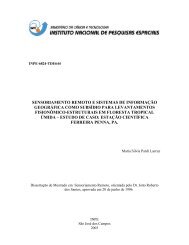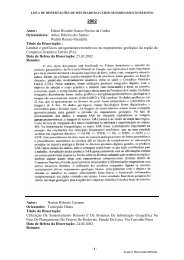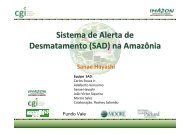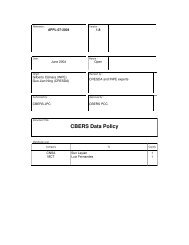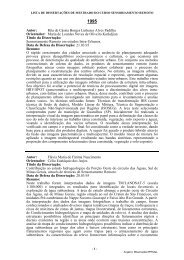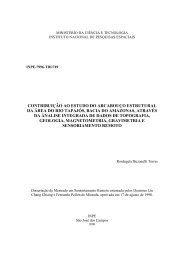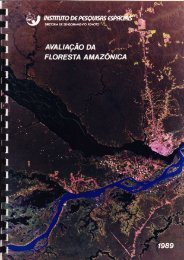MAPSAR: a small L-band SAR mission for land ... - OBT - Inpe
MAPSAR: a small L-band SAR mission for land ... - OBT - Inpe
MAPSAR: a small L-band SAR mission for land ... - OBT - Inpe
Create successful ePaper yourself
Turn your PDF publications into a flip-book with our unique Google optimized e-Paper software.
Acta Astronautica 56 (2005) 35 – 43<br />
www.elsevier.com/locate/actaastro<br />
<strong>MAP<strong>SAR</strong></strong>: a <strong>small</strong> L-<strong>band</strong> <strong>SAR</strong> <strong>mission</strong> <strong>for</strong> <strong>land</strong> observation<br />
Reinhard Schröder a,∗ , Jürgen Puls a , Irena Hajnsek a , Fritz Jochim a , Thomas Neff a ,<br />
Janio Kono b , Waldir Renato Paradella b , Mario Marcos Quintino da Silva b ,<br />
Dalton de Morisson Valeriano b , Maycira Pereira Farias Costa b<br />
a German Aerospace Center, DLR, P.O. Box 1116, D-82230 Weßling, Germany<br />
b NationalInstitute <strong>for</strong> Space Research, INPE, Av. dos Astronautas 1758, Caixa Postal515, 12201-010 São José dos Campos, SP-Brazil<br />
Available online 14 October 2004<br />
Abstract<br />
This paper introduces Multi-Application Purpose <strong>SAR</strong> (<strong>MAP<strong>SAR</strong></strong>). A new Synthetic Aperture Radar (<strong>SAR</strong>) <strong>mission</strong> <strong>for</strong><br />
earth observation. <strong>MAP<strong>SAR</strong></strong> is the result of a joint pre-phase A study conducted by INPE and DLR targeting a <strong>mission</strong><br />
<strong>for</strong> assessment, management and monitoring of natural resources. The applicability of the sensor system was investigated<br />
<strong>for</strong> cartography, <strong>for</strong>estry, geology, geomorphology, hydrology, agriculture, disaster management, oceanography, urban studies<br />
and security. An L-<strong>band</strong> <strong>SAR</strong>, based on INPE’s multi-<strong>mission</strong> plat<strong>for</strong>m (MMP), has been chosen as payload of the satellite.<br />
The key component of the <strong>SAR</strong> instrument is the <strong>SAR</strong> antenna, which is designed as an elliptical parabolic reflector antenna.<br />
L-<strong>band</strong> (high spatial resolution, quad-pol) has been selected <strong>for</strong> the <strong>SAR</strong> sensor as optimum frequency accounting <strong>for</strong> the<br />
majority of Brazilian and German user requirements. At the moment, the pre-phase A has been concluded and the phase A<br />
is planned to start in early 2003.<br />
© 2004 Elsevier Ltd. All rights reserved.<br />
1. Introduction<br />
The ability of a <strong>SAR</strong> to provide high-resolution imagery<br />
independent of weather or sun light is particularly<br />
important <strong>for</strong> regions of the planet that present<br />
restrictions to the use of optical sensors due to the presence<br />
of rain, perennial clouds, haze and smoke (e.g.,<br />
the Amazon region) or where solar illumination is<br />
∗ Corresponding author. Tel.: +49 8153 28 2310;<br />
fax: +49 8153 28 1135.<br />
E-mailaddresses: reinhard.schroeder@dlr.de (R. Schröder),<br />
kono@dss.inpe.br (J. Kono).<br />
insufficient (Polar regions). Beside this, imaging<br />
radars also have the ability to penetrate a vegetation<br />
canopy, which is not possible using optical sensors.<br />
In general, the acquisition of in<strong>for</strong>mation in tropical<br />
regions, particularly in rain <strong>for</strong>ests is complicated due<br />
to the large continental extension, poor accessibility,<br />
and complex nature of the environment. In particular,<br />
Brazil has a vast territory with a tremendous need<br />
<strong>for</strong> resource management in<strong>for</strong>mation such as can be<br />
provided by satellite imaging radars. Many obstacles<br />
have been faced <strong>for</strong> the integration of the Amazon region<br />
to the rest of the country. This integration is necessary<br />
nowadays more than ever with respect to the<br />
0094-5765/$ - see front matter © 2004 Elsevier Ltd. All rights reserved.<br />
doi:10.1016/j.actaastro.2004.09.007
36 R. Schröder et al. / Acta Astronautica 56 (2005) 35 – 43<br />
increasing Brazilian population and the immense natural<br />
(renewable and non-renewable) resources available<br />
in the region. <strong>SAR</strong> systems have not only the capability<br />
to image but also to measure bio-/geophysical environmental<br />
parameters of such a “complex environment”<br />
in a systematic and repetitive manner in support of<br />
natural resource assessment and the monitoring processes<br />
that are essential parts of procedures <strong>for</strong> sustainable<br />
environmental management.<br />
In the range of wavelengths used by imaging<br />
radar, backscatter intensity from terrain surfaces is<br />
strongly controlled by decimetre-scale changes in surface<br />
slopes, or by centimetre-scale roughness of the<br />
surface. Thus, the sensitivity of <strong>SAR</strong> to the macrotopography<br />
(slopes, tilts, broad undulations in the<br />
terrain), the surface roughness (roughness on the scale<br />
of the <strong>SAR</strong> wavelength) and to the presence of moisture<br />
or liquid water content of a medium affecting the<br />
complex dielectric constant, makes it an ideal instrument<br />
<strong>for</strong> thematic mapping and resource management<br />
purposes in the tropical region, and when stereoscopic<br />
capabilities are available, <strong>for</strong> topographic mapping.<br />
In addition, the large ratio of <strong>SAR</strong> return from <strong>land</strong><br />
versus water is primarily a function of contrast of<br />
dielectric properties and surface roughness, providing<br />
a striking interface which also facilitates coastal<br />
delineation and related mapping application (flooding,<br />
wet<strong>land</strong> and hydrological studies in the Brazilian<br />
Amazon).<br />
On the other hand, <strong>for</strong>est biomass is today one of<br />
the most unknown parameters in dynamic ecosystem<br />
change especially with respect to a reliable global<br />
Carbon-flux modelling. In many regions of our planet<br />
even a mere <strong>for</strong>est classification is missed. Parallel to<br />
the ecological dimension, and under the light of the<br />
Kyoto protocol, this problem has also a political dimension<br />
that increases the responsibility of the scientific<br />
community to provide exact answers. The fact that<br />
biomass in<strong>for</strong>mation is especially missed in remote<br />
areas (i.e. tropical and boreal <strong>for</strong>est ecosystems) combined<br />
with the fact that these ecosystems contain the<br />
biggest amount of <strong>for</strong>est biomass make remote sensing<br />
techniques a challenge. However, optical remote<br />
sensing sensors are in general not capable of measuring<br />
<strong>for</strong>est biomass or monitoring the dynamics of de<strong>for</strong>estation<br />
and biomass regeneration. An alternative<br />
methodology is the estimation of <strong>for</strong>est biomass based<br />
on the estimation of <strong>for</strong>est height from radar remote<br />
sensing data. One of the key challenges facing imaging<br />
radars is to <strong>for</strong>ce evolution from high-resolution<br />
qualitative imaging to accurate high-resolution quantitative<br />
measurement. One very promising way to extend<br />
the observation space is the combination of interferometric<br />
and polarimetric observations. <strong>SAR</strong> interferometry<br />
is today an established technique <strong>for</strong> the<br />
estimation of the height location of scatterers through<br />
the phase difference in images acquired from spatially<br />
separated locations at either end of a baseline.<br />
The initiative of the joint study of a <strong>small</strong><br />
spaceborne <strong>SAR</strong> is a consequence of a long-term<br />
Brazilian–German scientific and technical cooperation<br />
that was initiated between INPE and DLR in the<br />
1970s. The decision to per<strong>for</strong>m a pre-phase A study<br />
<strong>for</strong> <strong>MAP<strong>SAR</strong></strong> was established in 2001 following<br />
several meetings in both agencies ([1,2]). Based on<br />
the specific and complementary experience of both<br />
partners, the sharing of the thematic responsibilities<br />
within the study was agreed. Brazil is responsible<br />
<strong>for</strong> the plat<strong>for</strong>m and integrated satellite analysis and<br />
Germany <strong>for</strong> the payload and orbit analysis.<br />
2. User requirements<br />
The <strong>MAP<strong>SAR</strong></strong> <strong>mission</strong> is tailored to optimally support<br />
the potential user groups in both countries taking<br />
into account distinct aspects of specific applications.<br />
Thus, in April 2002, a working group of Brazilian<br />
<strong>SAR</strong> scientists and technical experts (potential <strong>SAR</strong><br />
end-users) met on the campus of INPE (São José dos<br />
Campos) to per<strong>for</strong>m a review of the use of imaging<br />
radar to derive surface characteristics important <strong>for</strong><br />
tropical applications. The first workshop of potential<br />
end-users of <strong>MAP<strong>SAR</strong></strong> was structured <strong>for</strong> the purpose<br />
of (1) per<strong>for</strong>ming an assessment of the current understanding<br />
of the applications of <strong>SAR</strong> in Brazil and (2)<br />
developing end-user requirements and recommendations<br />
aiming at a joint INPE–DLR <strong>small</strong> spaceborne<br />
<strong>SAR</strong> program.<br />
The consensus of the Brazilian working group<br />
was that a spaceborne <strong>SAR</strong> <strong>mission</strong> will provide a<br />
powerful new tool to acquire data and to derive important<br />
and unique in<strong>for</strong>mation of vegetated terrain<br />
of the Amazon Region. Due to the enormous scarcity<br />
of up-to-date in<strong>for</strong>mation, which is fundamental<br />
<strong>for</strong> planning and strategic decision-making about
R. Schröder et al. / Acta Astronautica 56 (2005) 35 – 43 37<br />
environmental assessment, management and monitoring<br />
of natural resources in the Brazilian Amazon, the<br />
proposed <strong>small</strong> spaceborne <strong>SAR</strong> initiative should be<br />
strongly oriented to a quasi-operational (“applicationoriented”)<br />
system. This is dedicated to thematic<br />
mapping purposes <strong>for</strong> topography, vegetation and<br />
de<strong>for</strong>estation, geology, hydrology, etc. Furthermore,<br />
it was strongly recommended to have a series of<br />
satellites aiming at the operational aspects and the<br />
program continuity. In addition, the <strong>MAP<strong>SAR</strong></strong> concept<br />
should also address aspects of integration with<br />
the Brazilian “Surveillance of the Amazon System”<br />
(SIVAM/SIPAM), due to the complementary nature of<br />
both sources (spaceborne/airborne) of multi-polarized<br />
and fully polarimetric L-<strong>band</strong> data. Finally, although<br />
recognised in most application fields, the effects of<br />
polarimetry and interferometry on the image in<strong>for</strong>mation<br />
content are not well understood in some of those<br />
fields.<br />
The Brazilian applications are of high interest <strong>for</strong><br />
the German potential user community. Additional applications,<br />
which are of specific importance <strong>for</strong> the<br />
German user side, as biomass estimation, disaster<br />
monitoring and security complement the Brazilian<br />
disciplines. The common aim is a global biomass<br />
mapping <strong>mission</strong> covering major <strong>for</strong>ests biomes of<br />
the globe (tropical and boreal regions). This requires<br />
the capability of polarimetric <strong>SAR</strong> interferometry <strong>for</strong><br />
<strong>for</strong>est height estimation which is directly related to<br />
<strong>for</strong>est biomass using allometry. The Brazilian and the<br />
German requirements have been merged resulting in<br />
the final user requirements <strong>for</strong> <strong>MAP<strong>SAR</strong></strong> presented<br />
in Table 1(a) and (b).<br />
Due to several restrictions related to INPE’s multi<strong>mission</strong><br />
plat<strong>for</strong>m (mass, power generation, geometric<br />
envelope and data rate) the following main limitations<br />
were imposed upon the satellite configuration: use of<br />
a single frequency and use of a light weight antenna.<br />
The resulting antenna concept limits the maximum<br />
instantaneous swath width to approximately 55 km.<br />
Table 2 summarizes the final specification.<br />
3. Payload configuration<br />
Based on these user requirements and plat<strong>for</strong>m limitations<br />
the design of the L-<strong>band</strong> <strong>SAR</strong> sensor is based<br />
on a reflector antenna concept. The main advantage<br />
is the possibility to realize full polarization and high<br />
<strong>band</strong>width with low technological risk at low costs.<br />
The main drawbacks are the limited instantaneous<br />
swath width and the lack of an electronic beam steering<br />
capability.<br />
3.1. <strong>SAR</strong> antenna<br />
A key problem <strong>for</strong> a L-<strong>band</strong> <strong>SAR</strong> is the large antenna<br />
size required compared to higher earth observation<br />
frequencies. Fig. 1 shows an approximation <strong>for</strong><br />
the minimum antenna size required to access various<br />
incidence angles at different orbit heights taking into<br />
account a sufficient ambiguity suppression of approximately<br />
−20 dB.<br />
It is obvious that a low orbit height reduces the<br />
antenna size requirements significantly. On the other<br />
hand, orbit heights below 500 km can become critical<br />
with respect to maintainability and drag compensation.<br />
To achieve a maximum incidence angle of 45 ◦<br />
an antenna aperture of at least 27 m 2 is necessary at<br />
600 km orbit height. Lower orbit heights would allow<br />
to reduce the antenna aperture, higher orbit heights<br />
would require to increase it. A reduction of the antenna<br />
dimensions as far as possible is mandatory taking<br />
into account the launcher and plat<strong>for</strong>m limitations.<br />
There<strong>for</strong>e, an orbit height as low as possible is advantageous<br />
<strong>for</strong> the <strong>SAR</strong> sensor design. Considering<br />
the requirements of the Brazilian multi <strong>mission</strong> plat<strong>for</strong>m<br />
it was agreed between the partners to concentrate<br />
the investigations on orbits with a height between 600<br />
and 650 km. There<strong>for</strong>e, the basis <strong>for</strong> the <strong>SAR</strong> sensor<br />
design was chosen to be at a height over ground of<br />
620 km. Variations of ±30 km do not affect the design<br />
significantly.<br />
The final choice of the antenna size is a trade-off between<br />
various parameters. We considered a Cassegrain<br />
configuration with an elliptical parabolic main reflector<br />
with 7.5 m length in azimuth and 5 m width in elevation.<br />
Neither the subreflector mounting nor the horntype<br />
prime radiator need to be folded. The resulting<br />
antenna gain in combination with a low orbit allows<br />
very good sensitivity with a reasonable power budget.<br />
3.2. Access region of the <strong>SAR</strong> sensor<br />
The antenna configuration and the restrictions imposed<br />
by a sufficient ambiguity suppression in azimuth
38 R. Schröder et al. / Acta Astronautica 56 (2005) 35 – 43<br />
Table 1<br />
<strong>MAP<strong>SAR</strong></strong> user requirements<br />
(a)<br />
Application/<strong>MAP<strong>SAR</strong></strong> parameters Agriculture Cartography Disaster monitoring Forestry<br />
Frequency LLC L ∗ ,C<br />
L C L L<br />
Polarization/polarimetry quad. pol N.E. VV, HH quad. pol.<br />
quad. polN.E. quad. pol quad. pol.<br />
Incidence interval Variable 25–45 ◦ variable (45 ◦∗ ) 20 ◦ –30 ◦ /45 ◦ –60 ◦ 20 ◦ –45 ◦<br />
45 ◦∗ variable 20 ◦ –45 ◦<br />
Spatial resolution 30 m 5 m 30–50/15 m 10 m<br />
3–5 m 3–5 m 3–5 m 10 m<br />
Swath 30 km N.A. 150–350 km 100 km<br />
30 km variable variable variable<br />
Orbit inclination N.A. sun-syn sun-syn sun-syn<br />
sun-syn sun-syn sun-syn sun-syn<br />
Look direction N.A. asc/desc asc/desc N.A.<br />
asc/desc asc/desc asc/desc asc/desc<br />
Revisit 15 days N.A. < 1 day monthly<br />
R. Schröder et al. / Acta Astronautica 56 (2005) 35 – 43 39<br />
Table 2<br />
<strong>MAP<strong>SAR</strong></strong> final specification taking into account user requirements<br />
and MMP constraints<br />
Off-nadir angle<br />
Frequency<br />
Polarization<br />
Incidence interval<br />
Spatial resolution<br />
Swath<br />
Orbit inclination<br />
Coverage<br />
Look direction<br />
Revisit<br />
Data access<br />
Additional requirement<br />
L-<strong>band</strong><br />
Single, dual and quad<br />
20 ◦ –45 ◦<br />
3–20 m<br />
20–55 km<br />
Sun-synchronous<br />
Global<br />
Ascending/descending<br />
Weekly<br />
Near real time<br />
Stereoscopy and interferometry<br />
620 km<br />
Incidence angle<br />
20˚<br />
48,1˚<br />
Nadir<br />
204 km<br />
395 km<br />
Fig. 3. Access region of the <strong>SAR</strong> sensor.<br />
Nadir Zone<br />
20 30 40 50 60<br />
30<br />
Orbit height= 500 km<br />
Orbit height= 600 km<br />
Orbit height= 700 km<br />
L-Band (f=1.3 GHz)<br />
5<br />
Ambiguities appr. -20 dB<br />
0<br />
0 10 20 30 40 50 60<br />
Incidence angle / deg<br />
Fig. 1. Minimum antenna size in L-<strong>band</strong>.<br />
25<br />
20<br />
15<br />
10<br />
Minimum antenna area /m 2<br />
between 20 ◦ and 48.1 ◦ incidence angle covering an<br />
area of 395 km on both sides of the satellite nadir track.<br />
In full polarization mode the PRF must be doubled,<br />
leading to a useful range between 5200 and 6000 Hz.<br />
The corresponding field of view is between 20 ◦ and<br />
39.3 ◦ incidence angle, covering an area of 245 km on<br />
both sides of the satellite nadir track.<br />
Fig. 3 illustrates the whole access region. Since the<br />
sensor has no electronic beam steering the current<br />
swath is selected by rolling the whole satellite in the<br />
necessary position. The same is done to change between<br />
left or right looking configuration. This results<br />
in certain restrictions to image regions within the same<br />
orbit which are close to each other in flight direction<br />
but separated in elevation by more than one instantaneous<br />
swath width.<br />
3.3. <strong>MAP<strong>SAR</strong></strong> radar modes<br />
Offnadir angle/ deg<br />
60<br />
50<br />
40<br />
30<br />
20<br />
transmit interference<br />
nadir interference<br />
PRF-RESTRICTIONS<br />
10<br />
2200 2400 2600 2800 3000 3200<br />
PRF / Hz<br />
Fig. 2. PRF <strong>band</strong>s with interference.<br />
DLR<br />
Based on the user requirements, <strong>MAP<strong>SAR</strong></strong> offers<br />
three different resolution modes (3, 10, and 20 m) operated<br />
in the conventional stripmap mode. The chirp<br />
<strong>band</strong>width is designed to operate in the full 85 MHz allowed<br />
by the World Administrative Radio Conference<br />
(WARC). This enables a high-resolution (HR) mode<br />
in the order of 3 m without increasing the complexity<br />
of the front-end and the antenna. For lower resolution<br />
modes the <strong>band</strong>width is reduced accordingly. A single<br />
polarization mode (SPM), a dual polarization mode<br />
(DPM) and a quad polarization mode (QPM) are <strong>for</strong>eseen<br />
<strong>for</strong> all of these resolution modes. Table 3 lists the<br />
sensor and per<strong>for</strong>mance parameters <strong>for</strong> some of these<br />
modes.<br />
As a baseline a RF peak power of 1000 W was<br />
considered. Depending on the priority of the different
40 R. Schröder et al. / Acta Astronautica 56 (2005) 35 – 43<br />
Table 3<br />
<strong>MAP<strong>SAR</strong></strong> radar modes<br />
Parameter HR mode MR mode LR mode<br />
High resolution Medium resolution Low resolution<br />
SPM DPM QPM<br />
Access region near far near far near far<br />
Resolution<br />
Range/m 4,7 3,1 10 10 20 20<br />
Azimuth/m 3,1 3,1 10 10 20 20<br />
Off-nadir angle/ ◦ 20,0 41,8 20,0 41,8 20,0 32,1<br />
Incidence angle/ ◦ 20,3 47,6 20,0 48,1 20,0 36,8<br />
Ground swath width/km 38,3 20,5 45,1 35 43,4 28<br />
PRF/Hz 2650 2718 2660 2680 5320 5320<br />
Pulse <strong>band</strong>width/MHz 85 85 42,5 21,25 21,25 21,25<br />
Sampling frequency/MHz 96 96 2 × 48 2 × 24 2 × 24 2 × 24<br />
Pulse length/μs 25 25 10 10 10 10<br />
Data rate/Mbit/s 262 300 267 300 247 249<br />
RF peak power/W 1000 1000 1000 1000 1000 1000<br />
Average DC power/W ∼ 490 ∼ 500 ∼ 440 ∼ 440 ∼ 440 ∼ 440<br />
NESZ/dB<br />
Image center −23,6 −19 −28,9 −25,4 −34,6 −33,3<br />
Image edge −17,0 −18,3 −19,9 −23,3 −26,6 −30,9<br />
Number of looks<br />
Range 1 1,33 1,14 1,13 1,04 1,73<br />
Azimuth 1 1 3,3 3,3 6,6 6,6<br />
Radiometric res./dB
R. Schröder et al. / Acta Astronautica 56 (2005) 35 – 43 41<br />
Table 4<br />
Radar beam specification<br />
Beam number/ Incidence angle Swath width/ Eff. PRF/<br />
km range/ ◦ km Hz<br />
1 19,93–23,95 45,1 2660<br />
2 23,76–27,32 41,9 3010<br />
3 27,12–30,71 44,5 2660<br />
4 29,69–33,31 46,9 2660<br />
5 32,86–36,52 50,4 2910<br />
6 36,15–39,86 54,8 2660<br />
7 39,50–42,69 50,0 2900<br />
8 42,22–45,24 51,0 2640<br />
9 45,16–46,92 31,6 2870<br />
10 46,28–48,08 33,5 2680<br />
Fig. 6. Average revisit time over Brazil.<br />
Fig. 5. Maximum revisit time over Brazil.<br />
The actual concept of the <strong>MAP<strong>SAR</strong></strong> <strong>mission</strong> favours<br />
an orbit with a repeat cycle of 37 days and an altitude<br />
of about 620 km. This orbit has an inclination of<br />
about 97.86 ◦ . The sensor field of view <strong>for</strong> this orbit is<br />
between 20 ◦ and 48.1 ◦ to fulfil the specifications of<br />
the users. Fig. 5 shows the maximum revisit times <strong>for</strong><br />
Brazil. The highest value is 132 h, but most regions of<br />
Brazil will be reached in less than 100 h.<br />
In Fig. 6, the average value <strong>for</strong> the revisit times can<br />
be seen. The maximum value over the northern part of<br />
Brazil is 42.3 h, but most regions have average revisit<br />
times far less than 40 h.<br />
Because of the fact that the latitude of the German<br />
regions ranges between 47 ◦ and 55 ◦ , the revisit times<br />
are quite lower than <strong>for</strong> some Brazilian regions. In<br />
detail, the maximum values can be seen in Fig. 7, the<br />
average values <strong>for</strong> Germany are shown in Fig. 8.<br />
Fig. 7. Maximum revisit time over Germany.<br />
Fig. 8. Average revisit time over Germany.
42 R. Schröder et al. / Acta Astronautica 56 (2005) 35 – 43<br />
Fig. 9. <strong>MAP<strong>SAR</strong></strong> satellite configuration.<br />
Fig. 11. MMP pictorial view (blow-up).<br />
Table 5<br />
<strong>MAP<strong>SAR</strong></strong> payload nominal mass budget<br />
Sub-system<br />
Mass (kg)<br />
4. <strong>MAP<strong>SAR</strong></strong> satellite<br />
Fig. 10. MMP block diagram.<br />
Mechanical structure 30.0<br />
Thermal control 4.0<br />
Radar sensor & data acquisition 193.6<br />
Data storage & transmitter 42.5<br />
Total mass 270.1<br />
Specified mass 280.0<br />
Nominal margin 9.9<br />
4.1. Satellite concept<br />
The <strong>MAP<strong>SAR</strong></strong> satellite utilizes a modular concept<br />
(Fig. 9), consisting of a payload module and the Brazilian<br />
Multi-Mission Plat<strong>for</strong>m (MMP).<br />
The MMP concept provides <strong>for</strong> a capability to support<br />
a variety of low earth orbit <strong>mission</strong>s using the<br />
same basic three-axis stabilized plat<strong>for</strong>m with different<br />
payload modules. The MMP block diagram and<br />
pictorial view are shown in Figs. 10 and 11. The MMP<br />
is already being developed by INPE and its first flight<br />
model shall be ready by the end of 2005.<br />
Thermal Control<br />
1%<br />
Structure<br />
11%<br />
<strong>MAP<strong>SAR</strong></strong><br />
Nominal Mass Budget<br />
Radar Sensor<br />
69%<br />
Margin<br />
4%<br />
Data Storage<br />
15%<br />
4.2. Mass budget<br />
Table 5 presents a summary of the nominal mass<br />
budget <strong>for</strong> the <strong>MAP<strong>SAR</strong></strong> payload.<br />
The total mass <strong>for</strong> the <strong>MAP<strong>SAR</strong></strong> payload is<br />
270.1 kg. Compared to the specified value (280.0 kg),<br />
this leads to a margin of 9.9 kg. This shows that, in<br />
Fig. 12. <strong>MAP<strong>SAR</strong></strong> payload mass breakdown.<br />
terms of mass, the proposed configuration is feasible.<br />
Fig. 12 shows the payload mass breakdown in a pie<br />
diagram.
R. Schröder et al. / Acta Astronautica 56 (2005) 35 – 43 43<br />
The ground segment <strong>for</strong> <strong>MAP<strong>SAR</strong></strong>, as a bilateral<br />
project, has to fulfil the requirements and account <strong>for</strong><br />
the existing infrastructure of each individual partner.<br />
In principle, the ground segment is, as usually in all<br />
large Earth observation projects, comprised of two essential<br />
elements, the FOS (flight operations segment)<br />
and PDS (payload data segment). Being a multilateral<br />
program, a clear definition of the responsibilities and<br />
the data policy have to be developed during the (future)<br />
engineering phase, defining the operational responsibilities,<br />
duties and rights of the individual partner. The<br />
following guidelines are in principle assumed:<br />
• The scientific community will be served by national<br />
institutions, a possible commercial user community<br />
will be served by data distributors. Both have to be<br />
served by the PDS.<br />
• Each partner will serve its user community in<br />
its own region (e.g. Brazil—Latin America;<br />
Germany—Europe). The data distribution over<br />
other regions has to be decided during the next<br />
program phases.<br />
• The FOS will be arranged in a primary and a secondary<br />
satellite control center, with equal functions<br />
managing the spacecraft according to a jointly defined<br />
timely structure. Both control centres use a<br />
joint network of TT & C ground stations <strong>for</strong> the<br />
LEOP and operational phase.<br />
Fig. 13. <strong>MAP<strong>SAR</strong></strong> satellite and launcher fairings.<br />
5. Launcher<br />
In terms of dimensions, the <strong>MAP<strong>SAR</strong></strong> payload<br />
layout is compatible with the majority of MMP<br />
considered standard launcher family. Fig. 13 shows<br />
the <strong>MAP<strong>SAR</strong></strong> satellite inside the launcher fairing<br />
dynamic envelopes. Some candidate launchers are<br />
excluded due to the envelope constraints imposed by<br />
the stowed reflector antenna envelope.<br />
6. Ground segment<br />
7. Conclusions<br />
An innovative <strong>small</strong> satellite <strong>mission</strong> with an L-<strong>band</strong><br />
<strong>SAR</strong> was described. The study was prepared by INPE<br />
and DLR, taking into account Brazilian and German<br />
user requirements. The preliminary feasibility was<br />
demonstrated <strong>for</strong> a reflector antenna concept. A high<br />
degree of innovation is presented in the design considering<br />
the <strong>small</strong> <strong>SAR</strong> payload, the reflector antenna<br />
and the remarkable sensor per<strong>for</strong>mance. The applications<br />
will take advantage of high spatial resolution<br />
L-<strong>band</strong> <strong>SAR</strong> with enhanced capabilities (polarimetry,<br />
stereoscopy, interferometry), particularly suitable <strong>for</strong><br />
the Amazon region and Boreal <strong>for</strong>est operations.<br />
The deployment of the reflector antenna and the<br />
solid state power amplifier are main technological<br />
challenges <strong>for</strong> this project, but nevertheless, after<br />
careful analysis, the <strong>SAR</strong> sensor is considered feasible<br />
and its development is estimated in 5 years.<br />
<strong>MAP<strong>SAR</strong></strong> launch is envisaged <strong>for</strong> 2008.<br />
References<br />
[1] INPE/DLR, <strong>MAP<strong>SAR</strong></strong> Pre-Phase A: Final Report, National<br />
Institute <strong>for</strong> Space Research (INPE) and Deutsches Zentrum<br />
für Luft und Raumfahrt (DLR), December 2002, 142pp.<br />
[2] www.obt.inpe.br/mapsar/mapsarindex1.htm.



